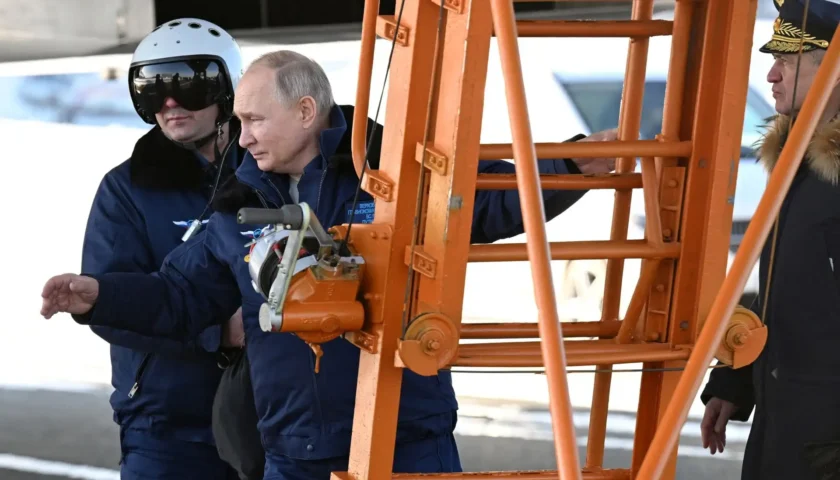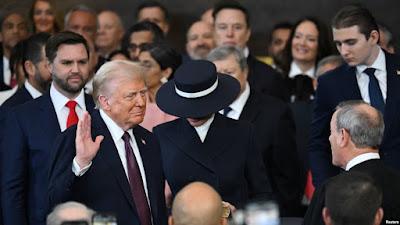A modernized Tu-160M nuclear-capable strategic bomber takes off in Kazan, Russia February 22, 2024. Sputnik/Dmitry Azarov/Pool via REUTERS
…Compliments The Capabilities Of The Supersonic Bomber In Carrying Out Nuclear Strikes
Russian President Vladimir Putin has said he will greenlight the modernized Tu-160M to enter service, after a flight on Thursday on board the nuclear-capable strategic bomber. The 30-minute flight from Kazan followed Wednesday’s inspection of the Gorbunov Aviation Plant, which is charged with modernizing the aircraft originally developed by the Tupolev Design Bureau in the 1970s. The bomber’s flight path was classified, according to the Kremlin.
“It is really a new machine, in many respects,” Putin said after the flight. “Even a layman can see that the controls are smoother. It’s very reliable, as is its armament. This is a new plane.”
The president described the modernized missile carrier as “truly next-generation technology” and said he would instruct the Defense Ministry to accept it into service with the air force. The giant swing-wing plane, codenamed “Blackjacks” by military alliance NATO, is a modernised version of a Cold War-era bomber that the former Soviet Union would have deployed in the event of nuclear war to deliver weapons at long distances.
Former President Dmitry Medvedev, now deputy chairman of Russia’s Security Council warned supplying Ukraine with F-16 fighter jets poses a risk of triggering a nuclear conflict.
“An accidental, unintentional outbreak of a nuclear conflict is not something to be discarded, which is why all those machinations around Ukraine are dangerous,” Medvedev said in an extensive interview with Russian journalists, as quoted by TASS on Thursday.

Russian President Vladimir Putin gets ready to fly on a modernized Tu-160M nuclear-capable strategic bomber, in Kazan, Russia February 22, 2024. Sputnik/Dmitry Azarov/Pool via REUTERS
The deputy head of Russia’s National Security Council cited the US-designed aircraft as a possible trigger, noting that Kiev wants them despite having no ground infrastructure to operate them.
“So, if one of those planes takes off from a NATO nation [on a Ukrainian mission] – what would that be? An attack on Russia. I shall not describe what could happen next,” he said. “Such a development may not be even sanctioned by the NATO leadership and the US.”
Russian officials previously warned that delivering F-16s to Ukraine would be highly problematic, considering that the jets can deploy nuclear gravity bombs.
Medvedev said Russia’s standoff with the US and its allies was not at a stage that would force people to hide in a nuclear shelter, but described it as worse than the 1962 Cuban Missile Crisis. The doomsday clock “is ticking” and has “sped up considerably,” he added.
The doomsday clock – a representation of the likelihood of a global catastrophe maintained by the Bulletin of the Atomic Scientists – is currently 90 seconds to midnight, having advanced 10 seconds last year.
Russia’s nuclear doctrine sets out the conditions under which a Russian president would consider using a nuclear weapon: broadly as a response to an attack using nuclear or other weapons of mass destruction, or to the use of conventional weapons against Russia “when the very existence of the state is put under threat”.
Putin, who is commander-in-chief of Russia’s armed forces, said in October that the existence of the Russian state was not under threat and that “no person of sound mind and clear memory would think of using nuclear weapons against Russia”.
Nuclear-capable Tu-160Ms have had up to 80% of their original systems replaced around the strategic bomber’s original airframe. Putin has proposed naming the newest aircraft after Mintimer Shaimiev, the first president of the federal Republic of Tatarstan, of which Kazan is the located.
The Tu-160M, along with the Tu-22M and veteran Tu-95 strategic bombers, remains a pillar of Russian long-range aviation. The plane was created primarily to carry nuclear-tipped cruise missiles, but it can also be equipped with a wide range of conventional munitions. The supersonic jet, which has a crew of four, is capable of carrying 12 cruise missiles or 12 short-range nuclear missiles and can fly 12,000 km (7,500 miles) non—stop without refuelling.
Under a contract signed with Tupolev signed in 2018, 10 of the modernised Tu-160M nuclear bombers are meant to be delivered to the Russian Air Force up to 2027 at a cost of 15 billion roubles ($163 million) each.
Source: X/RT/Reuters/Telegram/Kremlin





